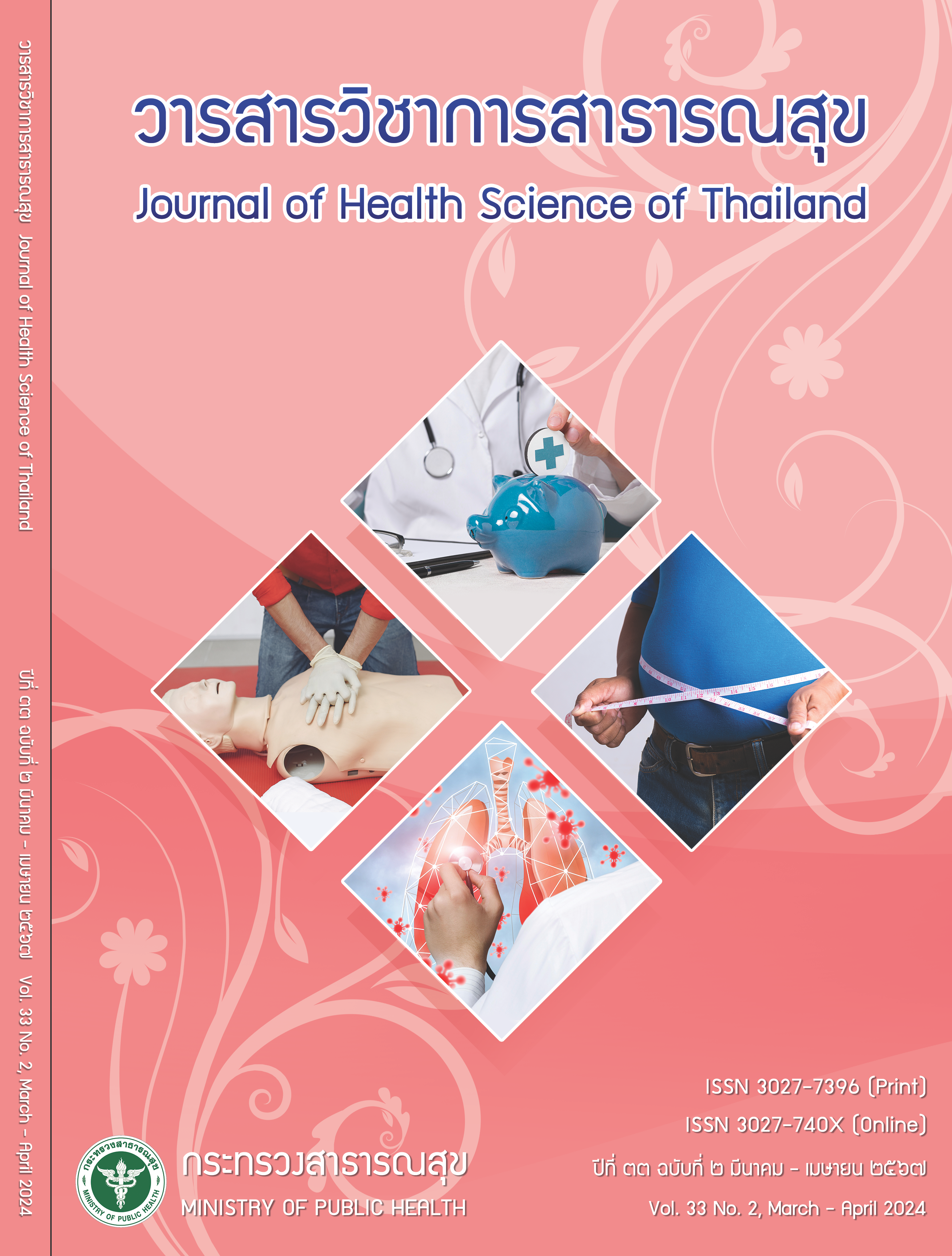Suicide Prevention Model within the At-Risk Group by Community Participation, Santisuk District, Nan Province
Keywords:
suicide attempt, suicide surveillance and prevention, community participationAbstract
These action research aimed to develop a model for preventing suicide within the at-risk group by community participation. Qualitative data was collected using observations and in-depth interviews with various key informants, including public health officials, health volunteers, community leaders, caregivers, and local government officers. A total of 44 purposive key informants were included to this study and data analyzed by content analysis. The study incorporated data from HosXP operation reports and statistical analysis were applied. The results showed that the model of preventive and control for suicide within the at-risk group have a characterized by a triangular framework by the community based. Collaborative efforts across different organizational levels were evident, guided by hierarchical command chains. Key mechanisms included: (1) support mechanisms from the policy units; the provincial public health office and provincial hospital; (2) integration mechanisms through District Health Board driven by district public health offices and hospitals; (3) communication and capacity-building mechanisms for health volunteers and caregivers through village health volunteers and designated hospital staff; and (4) surveillance mechanisms for suicide prevention by village health volunteers and caregivers. This operational framework increased suicide screening coverage and reduces suicide attempt rates within the at-risk group. The success factors included: (1) policy-driven coordination through district health board; (2) protocol and guideline for prevention with both proactive and reactive measures; (3) strong operational networks; and (4) formal and informal communication channels for coordination and learning exchange, including community health communication. This preventive and control for suicide within the at-risk group model could be apply for surveillance and prevention strategies, and be adopted as a guideline for similar areas through contextual adjustments and variables suitable for specific regional context.
Downloads
References
กรมสุขภาพจิต. โรคซึมเศร้ากับเหล่าเซเลป. [อินเทอร์เน็ต]. [สืบค้นเมื่อ 23 ก.พ. 2564]. แหล่งข้อมูล: https://www. dmh.go.th/news/view.asp?id=2278.
กรมสุขภาพจิตกระทรวงสาธารณสุข. รายงานอัตราการฆ่าตัว ตาย (รายต่อแสนประชากร)ปี พ.ศ. 2540-2563. [อินเทอร์เน็ต]. [สืบค้นเมื่อ 28 ก.พ. 2564]. แหล่งข้อมูล: https://www.dmh.go.th/report/suicide/stat_prov.asp.
พรรณพิมล วิปุลากร. Hfocus เจาะลึกระบบสุขภาพ [อินเทอร์เน็ต]. [สืบค้นเมื่อ 2 เม.ย. 2564]. แหล่งข้อมูล: https://www.hfocus.org/content/2021/02/20996.
ธัญญารัตน์ ปกรณ์ธนกุล. พัฒนารูปแบบประเมินคัดกรอง ภาวะซึมเศร้า 2 คำถามและ 9 คำถามที่เหมาะสมกับพื้นที่ หมู่บ้านปางช้าง ตำบลพงษ์ อำเภอสันติสุข จังหวัดน่าน [รายงานวิจัย R2R]. น่าน: สถานบริการสาธารณสุขบ้านปางช้าง; 2564.
นงคราญ คชรักษา, ศรีประไพ อินทร์ชัยเทพ. การพัฒนา รูปแบบการป้ องกันการฆ่าตัวตายโดยกระบวนการมีส่วนร่วม ของชุมชน จังหวัดลำปาง. วารสารแพทย์นาวี 2563; 47(2):446-63.
พุทธิพร พงศ์นันทกุลกิจ, สุทธีพร มูลศาสตร์, ปราการ ถมยางกูร. การพัฒนารูปแบบการป้ องกันการฆ่าตัวตายในกลุ่ม เสี่ยงที่มีภาวะซึมเศร้าในชุมชน จังหวัดจันทบุรี. วารสารวิจัยสุขภาพและการพยาบาล 2565; 38(2):187-97.
สุภางค์ จันทวานิช. วิธีการวิจัยเชิงคุณภาพ. กรุงเทพมหานคร: จุฬาลงกรณ์มหาวิทยาลัย; 2540.
สุภางค์ จันทวานิช. การวิเคราะห์ข้อมูลในการวิจัย เชิงคุณภาพ. กรุงเทพมหานคร: จุฬาลงกรณ์มหาวิทยาลัย; 2554.
Conelly L, But M, Goffart N, Taunton R. Methodological triangulation a study of nurse retention. Nursing Research 1997;46(5):299-302.
Cresswell J W. Research design: Qualitative and quantitative approaches. Thousand Oaks, CA: Sage; 1994.
ทวีศักดิ์ นพเกสร. วิธีการวิจัยเชิงคุณภาพ เล่ม 1. นครราชสีมา: โชคเจริญมาร์เก็ตติ้ง; 2548.
สุพัตรา สุขาวห, สุวรรณา อรุณพงศ์ไพศาล. ปัจจัยเสี่ยงและ ทฤษฎีที่เกี่ยวกับการฆ่าตัวตายในวัยรุ่น: การทบทวน วรรณกรรมเชิงลึก. วารสารสมาคมจิตแพทย์แห่งประเทศไทย 2560;62(4):359-78.
เนตรนภา ภมะราภา. การพัฒนารูปแบบเพื่อป้องกันการพยายามฆ่าตัวตายในผู้ป่วยซึมเศร้า จังหวัดอุตรดิตถ์. วารสารวิชาการป้องกันควบคุมโรค สคร.2 พิษณุโลก 2565; 9(3):92-107.
Wandersman A, Florin P. Community interventions and effective prevention. American Psychologist 2003; 58(6-7):441-8.
Zimmerman MA. Empowerment theory: psychological, organizational, and community levels of analysis. In: Rappaport J, Seidman E, editors. Handbook of community psychology. New York: Kluwer Academic Publishers; 2000. p. 43–63.
Downloads
Published
How to Cite
Issue
Section
License
Copyright (c) 2024 Ministry of Public Health

This work is licensed under a Creative Commons Attribution-NonCommercial-NoDerivatives 4.0 International License.







